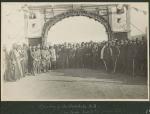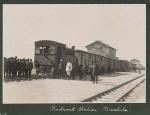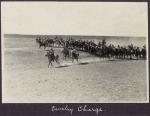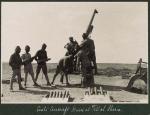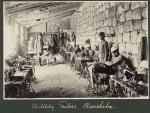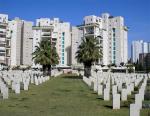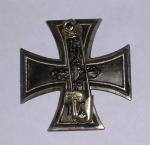-
Posts
3,687 -
Joined
-
Last visited
-
Days Won
2
Content Type
Profiles
Forums
Blogs
Gallery
Events
Store
Everything posted by Tony
-
200 years old and fantastic condition. Where did you find it, the US, Canada, Europe or elsewhere? Tony
-
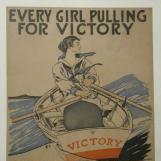
WW I German Artillery Panoramic Sight
Tony replied to Brian Wolfe's topic in Armour, Vehicles, Ships & Aircraft
Hello Brian, Now please don't quote me on this as I could be wrong but I believe DRP (Deutsche Reichspatent) indicates manufacture from 33 to 45. I would have a guess at Rundblick - Fernrohr being panorama telescope, probably also panorama periscope. Tony -

QUESTION ?
Tony replied to Mervyn Mitton's topic in Great Britain: Orders, Gallantry, Campaign Medals
Mervyn, If you'd like to pass on his details I can see if anything turns up on ancestry. Tony -

Herbert Wright, killed at Beersheba
Tony replied to Tony's topic in Great Britain: Orders, Gallantry, Campaign Medals
If only I could find the site and map again although it did look very similar to the b/w map photo above. Tony -

QUESTION ?
Tony replied to Mervyn Mitton's topic in Great Britain: Orders, Gallantry, Campaign Medals
Something Rifle Volunteers maybe? Does his number have a prefix? Tony -
Ah yes that right Mervyn. I now remember talking to Chris Boonzaier about the Boers and bayonets a few years back. Tony
-

Collar Dog ID
Tony replied to Stuart Bates's topic in Great Britain: Militaria: Badges, Uniforms & Equipment
Great photo Stuart. I hope someone can confirm the unit for you. Tony -

Herbert Wright, killed at Beersheba
Tony replied to Tony's topic in Great Britain: Orders, Gallantry, Campaign Medals
I did find a Turkish map showing the attacking formations in front of Beersheba or Beer Sheva as it's also known but all towns and units had Turkish names, therefore, I couldn't understand a thing. Tony -
Are their reports of hand to hand/bayonet fighting taking place during the Boer War? Tony
-

Herbert Wright, killed at Beersheba
Tony replied to Tony's topic in Great Britain: Orders, Gallantry, Campaign Medals
Allenby's dispatch 4th Light Horse Where I found much information Tony -

Herbert Wright, killed at Beersheba
Tony replied to Tony's topic in Great Britain: Orders, Gallantry, Campaign Medals
From The Age newspaper, 6.11.17 FIRST TROOPS IN BEERSHEBA GREAT WORK IN PALESTINE LONDON, 5th November. Further details of the fighting in Palestine which resulted in the capture of Beersheba have been received. The Australian and New Zealand mounted troops were the first to enter Beersheba. The enemy held extremely strong positions, but nothing went wrong with the attack. In the moonlight the Australian Horse charged up with bayonets fixed to their rifles. They overwhelmed the Turks and galloped cheering into the town. THE OPERATIONS DESCRIBED. Mr. W. Massey, the "Daily Telegraph" correspondent with the troops in Palestine, describes the operations in a stirring despatch. He says:— "Lieutenant-General Sir E.H. Allenby's surprise blow, which smashed up the eastern end of the Turkish line, wrested Beersheba from the enemy. There was a stern fight all day, in which the New Zealand and Australian mounted troops and British infantry displayed great endurance and courage, doing everything that will add glory to the lads from the English cities and shires and Australia and New Zealand. The splendid British infantry, after a series of long night marches, attacked with such determination that they tore down the wire entanglements with their hands. Then as the moon rose over the hills of Judea the Australian Horse dashed in upon the strongly held trenches and captured the town. "At dawn on 31st October the Australians and New Zealanders were at Beersheba with the British infantry, facing the northern, western and south-western defences, which had been cut in a range of hills which hid Beersheba from view. The Turkish entrenchments were elaborate, skilfully chosen and heavily protected by wire. Guns covered all approaches. Prisoners declare that it was believed that Beersheba was impregnable. "General Allenby's astonishing success was in concealing his march across the sunparched desert. On the 27th 3000 Turks with 12 guns attacked the British cavalry screen occupying high ground near the Jerusalem-Beersheba railway. The British squadron held out throughout the day. Both flanks were enveloped and another was surrounded on three sides. They beat-off two determined cavalry charges, and when the infantry arrived they were able to occupy the ground without fighting. The British infantry marched at night, hiding in the daytime. There was beautiful moonlight on the night of the 30th. The Australians and New Zealanders made a wide and rapid sweep to the south east in order to rush in at dawn and get astride of the Heoron road to prevent a Turkish retirement. The infantry attacked Hill 1070 and succeeded with an irresistible rush within half an hour, though a German machine gun section occupied the hill. The British infantry then pressed on to the Wadi Saba trenches, making rushes across the open, and not heading an enfilading gun fire and spasmodic machine gunning. Our bombers dashed in wherever our artillery broke down the wire. Everywhere the British soldiers tore the wire down from the iron supports with their hands. It was grand work. These English countrymen showed inspiring courage and resource. Though they were fighting for twelve hours they captured one defence after another, until at 9.30 p.m. all of the Beersheba stronghold was in our hands. "There is every evidence that the Turks were completely surprised. A train was standing at the station, and store houses full of corn were almost intact. The 31st October was a great day for the Palestine army. The stall work was admirable and the morale of our troops was never higher." Official reports from 31st October stated 15 guns and 441 prisoners including 26 officers. The 4th Light Horse Brigade captured 38 officers and 700 ORs as well as four field guns. Both regiments taking part in the charge lost only 31 men killed, including two officers and 36 men wounded including eight officers. Total casualties to the Desert Mounted Corps was 53 killed and 144 wounded. The British infantry suffered the heaviest losses - 116 killed in action and thus paved the way for the cavalry victories. -

Herbert Wright, killed at Beersheba
Tony replied to Tony's topic in Great Britain: Orders, Gallantry, Campaign Medals
-

Herbert Wright, killed at Beersheba
Tony replied to Tony's topic in Great Britain: Orders, Gallantry, Campaign Medals
-

Herbert Wright, killed at Beersheba
Tony replied to Tony's topic in Great Britain: Orders, Gallantry, Campaign Medals
The following photos of life in Beersheba came from http://www.palestineremembered.com/Beersheba/Beersheba/index.html#Pictures -

Herbert Wright, killed at Beersheba
Tony replied to Tony's topic in Great Britain: Orders, Gallantry, Campaign Medals
After Beersheba the EEF went on to fight the Battle of El Mughar Ridge on 13th November 1917 at Junction Station, where the Haifa-Jerusalem line branches to Beersheba. The battle was won and caused the Ottoman Empire's Seventh and Eighth Armies to withdraw towards Jerusalem and Haifa. Empire forces now moved on Jerusalem. The left flank was at Jaffa and the right flank was moving through the Hills of Judea Erich von Falkenhayn's reinforcements had by now arrived and he planed to launch a counter offensive. Fighting in or near Jerusalem was to be avoided by both sides. The Turks had fortified various places in a ring around Jerusalem, which included the hilltop of Deir Yassin - von Falkenhayn immediately started a series of attacks against British imperial troops. On the 8th December the heights west of Jerusalem were taken as were positions south of Bethlehem. Counter attacks had failed and Jerusalem fell to the British the next day. I wonder if Herbert's family had received notice of his death before reading about the successful outcome of 3rd Gaza in the papers. The military cemetery in Beersheba was made immediately after the fall of the town, remaining in use until July 1918, by which time 139 burials had been made. It was greatly increased after the Armistice when burials were brought in from a number of scattered sites and small burial grounds. The cemetery now contains 1,241 Commonwealth burials of the First World War, 67 of them unidentified. -

Herbert Wright, killed at Beersheba
Tony replied to Tony's topic in Great Britain: Orders, Gallantry, Campaign Medals
A Report from the New York Times -

Herbert Wright, killed at Beersheba
Tony replied to Tony's topic in Great Britain: Orders, Gallantry, Campaign Medals
-
A soldier of the 22nd London (Bermondsey) Batt. kia at Beersheba 1917 Herbert Wright has such a common name that it isn't easy to research him with my limited possibilities. His service record doesn't exist either. Herbert was born in Sherwood in 1890 and later lived in Reigate, Surrey. His MIC shows only his entitlement to the BWM and VM, it doesn't mention his entry to theatre or even that he was killed while taking part in quite a well known battle – Beersheba. During the one day battle of Beersheba (start of 3rd Gaza), what was probably the last ever mass charge by mounted units took place and until now, I thought Beersheba was purely an Anzac action. British infantry played a major roll in this battle, attacking Hill 1070, completely surprising the Turks and German machine gunners. The capture of Beersheba secured a supply of water to troops and animals advancing towards Jerusalem. The 22nd Londons formed part of the 60th Division, 181st Brigade, XX army Corps, arriving at Moascar camp in the southern Suez Canal on 20th June 1917. The following are entries from the 22 London battalion diary: October 17th Practice Smoke Attack with wire cutting. Brigade Communication Scheme with Battn & Coy. H.Q. October 17th-19th COL. BORTON, CAPT. EASTWOOD, CAPT. GRANT, CAPT. HODGE, 2ND. LT. BLAKEY, LT. JONES, 2ND. LTs. BOND, COULDREY, LARKIN, and 12 NCOs' on mounted reconnaissance of Turkish positions on Hill 1070 (Ref. YAHIA 1/20,000). After night at GAMLI, the party proceeded to the position of assembly (YAHIA )1/20,000 K.S.a), but were unable to reach PEMBROKE WADI on account of enemy snipers holding the ridges. The party withdrew soon after 1700 hours & spent the night at GAMLI. October 20th-25th Battn. marched from Camping Area at 1930 hours & relieved the 2/20th Lond. Regt. at K.22.C. (GAZA SHELIAL 1/20,000). "A" & "B" Coys held two posts in the line & "C" & "D" Coys were in support. October 26th-27th - Bn. was relieved by the 16th Bn. Sussex Regt and marched to GAMLI where it remained for the night of the 26th-27th. October 28th.- 181st Infantry Brigade marched to RASCHID BEK with the 2/24th London Regt. as advanced Guard assisted by the Corps Cavalry Regt. October 29th - The Battalion bivouacked at 0. 10.c. (ESANI. 1/20,00 for the night of 28th & 29th. COL. BORTON, CAPT. EASTWOOD, LIEUT. HAYFORD, 2nd. LIEUTS. BLAKEY, BENWELL, AXFORD, LARKIN and 4 Sergeants of "A" Coy on reconnaissance to Turkish positions on Hill 1070 (YAHIA 1/20,000). October 30th - 31st 21st Infantry Brigade marched to point of Assembly, K.2.C.4.3. (Ref. YAHIA 1/20,000) "A" Coy advance Guard under 2nd. Lt. BLAKEY, M.C. From the point of Assembly the Battn. moved in PEMBROKE WADI, "A" Coy driving back enemy outposts & forming a protective screen. From this WADI the attacking Coys moved forward into ABUSHAR WADI. After preliminary bombardment with a view to wire cutting, the Artillery gave 10 minutes intensive shelling from 0830-0840 hours during which the Battalion moved up to the enemy wire. At 0840 hours the attacking Coys "C", "D" & "B" attacked and captured the Turkish positions Z 18, Z 19 & Z 19a respectively known as Works 1070. Casualties: 2nd. LIEUT. J.J. HURST & 2nd.LIEUT. D. J. COULDREY killed; LIEUT. E. C. BRASSEY & 2nd. LIEUT. E J .LARKIN wounded; Other Ranks 14 killed, 78 wounded & 2 missing. Many prisoners were taken, and about 50 dead Turks were counted in the trenches. October 31st - Nov 1st At dusk the Battalion took up an outpost position from J.25.C.8.8. to J.19.a.8.6. (Ref. YAHIA 1/20,000). November 1st-3rd Battalion occupied outpost position J.25.C.8.8. to J.19.a.8.6. (Ref. YAHIA 1/20,000) and cleared battlefield. November 3rd -1917 181st Infantry Brigade marched to Y 18.d. (Ref. YAHIA 1/20,000) halting for 6 hours south of BEERSHEBA. where MAJOR-GENERAL SHEA, G.O.C., 60th Division, presented the Military Medal to No. 682291 PTE. CROAD H.T. and No. 684402 PTE. JOHNSON .F. November 4th - Battalion moved to outpost position W.4.c.4.3» to — W.3.d.40 to W.15 A 55 relieving 12th Norfolk Battn. November 5th Remained in Outpost position. The soldiers died CD show the following ORs killed on 31.10.17: Arthur Barnes from Bermondsey Henry Herbert Bennett from Deptford John George Cradock from Ealing Arthur George Ellis from Guildford George Henry Fathers from Peckham James Henry James from St. Ives (formerly Wessex Regt.) Gordon Conrad Lambert from Brenchley Albert Ross Mitchell from Catford Charles Alfred Mitton from Clapton Park (a possible relative Mervyn ????) William Powell from Bermondsey George Scan from Maida Vale Herbert Wright from Bletchingly 181st (2/6th London) Brigade 2/21st (County of London) Battalion, The London Regiment (disbanded in June 1918) 2/22nd (County of London) Battalion, The London Regiment 2/23rd (County of London) Battalion, The London Regiment (until May 1918) 2/24th (County of London) Battalion, The London Regiment (until May 1918)
-

Collar Dog ID
Tony replied to Stuart Bates's topic in Great Britain: Militaria: Badges, Uniforms & Equipment
I'm finding it difficult to tell. Doesn't the DLI collar dog have the letters DLI under the tassels? Tony -
Thanks very much for the confirmation Bill, I wasn't sure if it was a G or C on the ring. Tony
-

Hungary 1956, as my Grandfather saw it.
Tony replied to Peter Orincsay's topic in Central & Eastern European States
Peter, I never show much interest in post 45/cold war photos but these are absolutely fantastic. Tony -
Joe, I can even imagine a rebellious old grandad fixing it up in the 60s to wear at a mates funeral. Or even someone who was under the impression he should have been awarded the EKI. Off topic but I'll never forget seeing an old man wearing his miniature WWII lapel pin with 5 awards (EKI, II and wound badge in gold amongst them) while on the way back from buying a loaf back in the mid 90s when living in Germany. They weren't 1957 issue. Tony
-
Here's a transitional/converted EKI/EKII. I know we generally think these were converted in the field, probably due to the poor quality workmanship but couldn't be possible that these were also done at home by an old soldier who couldn't afford to replace a lost/misplaced 1st class cross after 1933 when they came back into fashion? Tony



